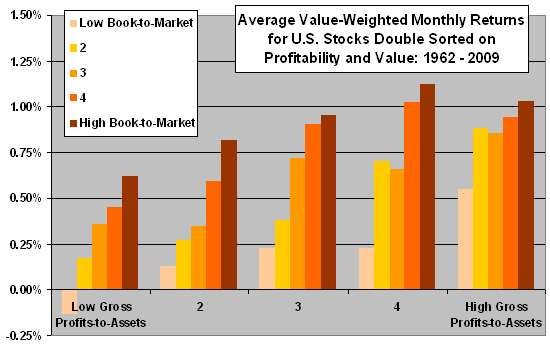Is level of profitability alone, and in combination with other firm/stock characteristics, a useful indicator of future stock returns? In his April 2010 paper entitled “The Other Side of Value: Good Growth and the Gross Profitability Premium”, Robert Novy-Marx investigates the power of the gross profits-to-assets ratio to predict returns for individual stocks as a standalone indicator and in combination with the book-to-market ratio. Using annual firm characteristics and stock price data for a broad sample of U.S. companies spanning 1962-2009, he concludes that:
- Gross profits-to-assets outperforms both earnings and free cash flow in predicting future returns of individual stocks. In fact, it completely subsumes the predictive power of earnings. Gross profits-to-assets also predicts long run growth in earnings and free cash flow.
- A value-weighted portfolio that is long (short) the fifth of stocks with the highest (lowest) gross profits-to-assets generates an average monthly excess return, relative to the risk-free rate, of 0.33% over the entire sample period. The associated three-factor alpha (adjusting for market, size and book-to-market) is 0.55% per month.
- Gross profits-to-assets has roughly the same, but complimentary, predictive power for future stock returns as book-to-market. A portfolio allocated half to the above gross profits-to-assets strategy and half to a similar value-weighted book-to-market strategy, rebalanced monthly, generates an average monthly excess return of 0.75%.
- Controlling for gross profitability dramatically improves the performance of value strategies, especially among large, liquid stocks. A value-weighted portfolio that is long (short) the extreme high gross profit-to-assets, high book-to-market (low gross profit-to-assets, low book-to-market) produced by a double sort on the two ratios generates an average monthly excess return of 1.16% (see the chart below).
- Applying gross profits-to-assets within rather than across industries dramatically increases its predictive power.
- A four-factor model based on market and industry-adjusted value, momentum and gross profitability factors explains remarkably well a wide range of anomalies, including those based on earnings yield, free cash flow growth, return on equity, asset growth, default risk and net stock issuance.
The following chart, constructed from data in the paper, shows the value-weighted average excess returns per month for 25 portfolios formed by monthly double sorts first on gross profits-to-assets and then on book-to-market. The sample excludes financial firms and covers July 1963 to December 2009 (using data since 1962). Profitability helps isolate “good growth” and “bad value” stocks. Results suggest that the value effect is stronger among unprofitable stocks, while the profitability effect is stronger among growth stocks.

All return calculations exclude trading frictions, which would materially reduce average returns.
In summary, evidence indicates that investors may be able to exploit gross profits-to-assets as a predictor of individual stock returns, especially within industry. The effect is comparable in magnitude and complimentary to book-to-market, such that combining them is especially powerful.